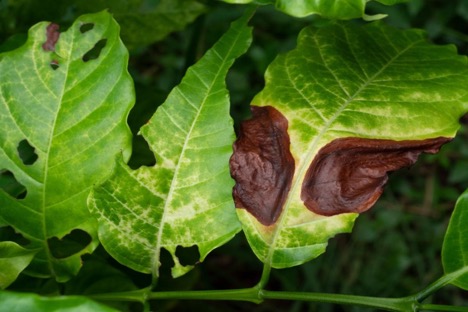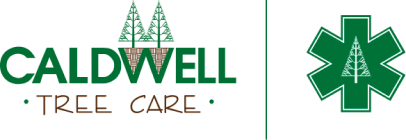
Trees are essential to the beauty and health of our environment, providing shade, oxygen, and habitat for countless species. However, trees can fall victim to various diseases and conditions that threaten their wellbeing and longevity. With over 30 years in the Atlanta, GA region, we at Caldwell Tree Care are experts in addressing the unique challenges and common diseases that affect local tree species such as Evergreens and Magnolias.
With our arborist consulting services, we perform in-depth hazard evaluations and tree surveys to make an accurate diagnosis and formulate a treatment plan. From structural pruning to necessary tree removal, we deliver cost-effective resolutions that last. Take a look at some of the telltale signs of dying trees and diseases that we’ve compiled, then give us a call if you think an otherwise healthy tree on your property needs some TLC.
Common Tree Diseases in Atlanta, GA
The Atlanta region is home to a variety of tree species, each susceptible to specific diseases. Understanding these common tree diseases can help you identify and address issues early.
Dutch Elm Disease
Dutch elm disease is a destructive fungal disease that spreads through root grafts between elm trees, disrupting their vascular systems and hindering the flow of water and nutrients. This ultimately leads to wilting, branch die-off, and the death of the tree. The disease is carried by elm bark beetles, and while there is no cure, there are some effective treatment options.
Root Rot
Root rot is a common plant disease that affects the underground portion of plants. It occurs when the roots are exposed to excessive moisture for prolonged periods, creating an environment conducive to fungal growth. As the disease progresses, it impairs the plant’s ability to absorb water and nutrients from the soil, leading to overall decline. Root rot can be caused by various pathogens, with some species specializing in certain types of plants. If severe enough, this condition can ultimately result in the death of the entire tree.
Anthracnose
Anthracnose is a group of fungal diseases that affect a wide variety of trees, shrubs, and other plants. It is caused by several species of fungi, primarily in the genus Colletotrichum. This disease can impact both deciduous and evergreen trees, with some species being more susceptible than others. Anthracnose thrives in cool, wet conditions, often becoming most prevalent during spring and fall.
While it can occur in various parts of the world, it is particularly common in regions with temperate climates. The severity of anthracnose infections can vary greatly, ranging from minor cosmetic damage to more serious effects on tree health and vigor in severe cases.
Fire Blight
Fire blight is a devastating bacterial disease that primarily affects trees and shrubs in the Rosaceae family, including apple, pear, and crabapple trees. The disease is caused by the bacterium Erwinia amylovora, which can spread rapidly through an orchard or landscape, especially during warm and humid weather conditions.
As the infection progresses, it can lead to the death of branches, limbs, and even entire trees if left untreated. Fire blight has significant economic implications for commercial fruit growers and can also pose a serious threat to ornamental trees in residential and public spaces.
Recognizing the Signs of a Dying Tree
The good news is that an unhealthy tree will display distinct symptoms, allowing you to take swift action and call our pros for help.
Look at the Tree’s Leaves and Branches
Leaves are often the first indicator of a tree’s health. Healthy trees boast lush, green foliage. Conversely, wilted or yellowish leaves signal a sick tree. Seasonal changes aside, persistent leaf discoloration often signifies underlying problems. For instance, Dutch elm disease causes yellowing leaves, leading to branch dieback and, eventually, a dead tree if untreated.
Infected branches also exhibit unusual leaf patterns. When the tree’s leaves curl, misshape, or show spots, it indicates pests or diseases. Regularly inspecting the tree canopy ensures early detection of these issues. If you spot any abnormalities in the tree’s leaves, it’s crucial to consult an arborist immediately.
Browse the Tree’s Bark and Trunk
The tree’s bark serves as a protective layer. Peeling tree bark can be normal for some species, but extensive peeling or cracks usually indicate distress. For instance, the outer layer of bark in pine trees flakes naturally. However, sudden peeling bark in oaks or maples often points to fungal infections or pest infestations.
The tree’s trunk also provides vital clues about its health. A tree trunk with deep cracks or holes might suffer from internal decay, posing a risk to nearby structures and people. Inspect the trunk for any signs of disease or damage and seek a professional evaluation if needed.
Review the Tree’s Roots & Soil
Tree roots anchor the plant and absorb nutrients. But, overwatering and poor soil drainage are common culprits of root-related issues. While it can be difficult to observe the roots directly for signs of disease without extensive digging, the soil surrounding trees can provide some clues. Look for changes in the soil around the base of the tree.
If the roots are rotting due to disease, the tree may be struggling to take up water, leading to compacted, dry soil. Conversely, overly wet and mushy soil can also indicate root problems. In some cases, fungal growths like mushrooms or conks popping up near the base of the tree may signal root decay.
Presence of Pests
Pests such as borers, aphids, and caterpillars can severely affect a tree’s health. Borer insects, in particular, burrow into the tree’s bark and lay eggs, which hatch into larvae that feed on the tree’s wood. This can cause extensive internal damage and compromise the tree’s structural integrity. Look for signs like holes in the bark, sawdust-like material, and the presence of insects to identify pest infestations.
How Caldwell Can Treat and Prevent Tree Disease
Treating tree diseases requires expertise and precision, which is exactly what our team at Caldwell Tree Care offers. Our certified arborists are trained to diagnose a wide range of tree diseases accurately. Once a disease is identified, we craft a customized treatment plan tailored to the specific needs of each tree and its environment.
Whether it’s combating Dutch elm disease with fungicidal injections or addressing root rot through soil remediation, our approach is both thorough and effective. We utilize advanced techniques and tools to guarantee that treatments are applied efficiently, minimizing stress on the tree. Our team also stays updated with the latest research and best practices in arboriculture, so you can rest assured that our methods are cutting-edge.
Preventing tree diseases from recurring is as crucial as treating them. We offer preventive care services such as regular inspections, proper pruning, and soil management to keep diseases at bay. By identifying potential threats early, we can implement measures to mitigate risks before they become serious problems.
Additionally, we educate property owners on best practices for tree maintenance. Simple actions like correct watering and fertilizing can significantly reduce the risk of disease. Mulching around the base of trees helps retain soil moisture and improve soil health, further bolstering the tree’s defenses.
Think Your Tree is Dying? Call Now for Help from Our Arborists
Your trees are valuable assets that require proper care and attention. If you notice any signs of distress in your trees, don’t hesitate to contact us. Our expert arborists will provide the necessary care to ensure your trees remain healthy and vibrant.
